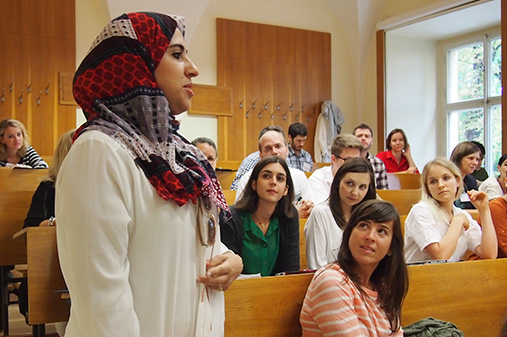Electrophysiology with a focus on cortical myoclonus
Prof. Marina de Koning-Tijssen: [00:00:00] Hello and welcome to the MDS Podcast, official podcast of the International Parkinson and Movement Disorder Society. Today we're in the second episode of the Myoclonus Special Series. I am Marina de Koning-Tjssen. I'm a neurologist and head of the Expertise Center of Movement Disorders in Groningen the Netherlands, and I'm here today with two guests, Anna Latorre, Consulted Neurologist at the Department of Clinical and Movement Neurosciences, Queen Square London, and Shabbir Merchant, Assistant Professor of Neurology at Harvard Medical School and Beth Israel Deaconess Medical Center. Anna was trained at the University of Sapienza in Rome, and later worked with Kailash Bhatia and John Rothwell at Queen Square.
View complete transcript
She's a member of the MDS Clinical Neurophysiology Study Group and recently [00:01:00] became the first author of a paper of that study group on using electrophysiology to assess jerky movements. Shabbir trained with Professor Stanley Fahn at Columbia University and completed a fellowship with Professor Mark Hallett at the NIH in Washington before moving to Harvard. He was the founding co-chair of both the MDS Clinical Neurophysiology Task Force and Study Group. Both Anna and Shabbir have a strong interest in clinical neurophysiology for movement disorders, focusing on objective diagnosis, phenotyping, and enhancing the understanding of the pathophysiology. The topic of today is electrophysiology with a focus on cortical myoclonus. Anna and Shabbir welcome. I would like to start with the first question, and perhaps Anna you can start there. What are the clinical phenotypes of the different anatomical forms of [00:02:00] myoclonus? Can you say something about that?
Prof. Anna Latorre: Yes. Thank you. I think that one of the most fascinating aspect about myoclonus is that it can arise from different parts of the nervous system, central and peripheral, and this makes the clinical presentation incredibly varied and sometimes tricky to localize. But traditionally, myoclonus is being classified anatomically into cortical subcortical, including basal ganglia such as a myclonus dystonia, brainstem myoclonus, spinal, including sedimental and propriospinal and peripheral types.
However, more recently it has been proposed a new myoclonus consensus with a new anatomy physiological classification, which is slightly different, and includes the cortical subcortical brain stem, spinal, propriospinal, peripheral, and functional myoclonus. I think it's important just to align two aspects.[00:03:00]
One is the introduction of cortical subcortical category, which is a bit new for movement disorder experts, but it reflects a physiological, distinct phenomenon with excessive bidirectional neural activity between cortical and subcortical circuitry as seen in myoclonus epilepsy. And secondly, also the addition of functional myoclonus, which is rather an neurological rather than a strict anatomical category, but it was included because of its clinical relevance and the presence of distinct neurophysiological markers.
Prof. Marina de Koning-Tijssen: And Shabbir, can you reflect a bit on how you would use electrophysiology to discriminate between the different types of myoclonus?
Prof. Shabbir Merchant: Yeah. Thank you Anna. That was, it was a very excellent overview, so makes things much easier for me. But thank you for inviting me for this important discussion and to be able to give a few of my opinion and share my experience with it. I think what Anna [00:04:00] puts it is very good in terms of the classification in terms of localization, I think, from a practical standpoint, and that's what Marina, with your help and mentorship, we've been trying to make things easier in terms of how we can incorporate all this interesting ideas and input from the pathophysiology into daily clinical practice. So to simplify, I think the approach which we want to put forward to the practitioner is that the approach to diagnose these movements is very simple.
I think the idea is that if you have a couple of surface electrodes. You can put it in certain body regions. That itself is so much more sensitive and specific compared to our current approach where any jerk like movement, which we see is mislabeled. I would say myoclonus because I personally think that myoclonus should be a physiologic diagnosis. What you describe as phenomenology can be jerky movements. It can be from many different things and many different things. Look like the same. So I think when we use the term myoclonus, and I'm [00:05:00] hoping that we start to use an objective way in which we describe, when we use the term or qualify the term myoclonus, it is qualified with certain spatial and temporal aspects of the movement recorded.
So I'll give you a very simple example for the category of cortical and subcortical myoclonus, if you apply a couple of surface electrodes to your forearm, because the cortical myoclonus distribution usually you wanna involve the face and the arm. So just by putting a couple of surface electrodes in the arm, if you record simultaneous agonist antagonist activity at a burst duration around 50 milliseconds or so, or even if you go up to a hundred milliseconds. If the burst duration is simultaneous agonist antagonist activity in a muscle, it cannot be anything but a cortical or subcortical myoclonus. You have ruled out a functional jerk.
You have ruled out total related problem. You have ruled out prop or spinal related pathologies. Just by doing a very simplistic way of doing this again, then you can qualify that by [00:06:00] localizing it. You can do all these studies or back averaging looking at the origin within the nervous system.
But I'm saying just by looking at these very simple burst duration, the localization of the burst, and if you have a generalized jerky movement by applying electrodes in the different cranial nerves and the muscles of the axial and appendicular skeleton. And just by looking at the time duration it takes from traveling of the wallys from one location to the other, it gives you a very simple idea about the pathway in the nervous system.
This jerky movement is traveling through, and that itself will give you a very good diagnosis in terms of whether this is a jerky movement from a reticular system originating from a reticular myoclonus, which is a brainstem related problem. Or your most favorite thing is startle myoclonus, which can originate in a little bit of, in the pons.
And the velocity of conduction of those wallys is a little bit different. So I think by using very [00:07:00] simple measures of just looking at this recorded movement in a very simplistic way, you can improve the diagnostic accuracy. And one of the largest series which produced just in about close to 90% of the diagnosis of cortical myoclonus can be made just on the basis of this very simple measure of recording simultaneous agonist antagonist activity and looking at the burst duration.
So that's the approach that we need to educate and say so that it can be easily incorporated into the clinical practice.
Prof. Marina de Koning-Tijssen: Thank you, Shabbir. And then Anna, I liked the idea of Shabbir, just using simple EMG registrations on one hand to see the simultaneous burst activity. But how would you discriminate between cortical and subcortical, because that makes a difference in how you would subsequently try to find the cause of the myoclonus.
Can you say something about that?
Prof. Anna Latorre: Yes of course I think the most challenging [00:08:00] differential diagnosis is indeed often between cortical and subcortical. And this as Shabbir well said, EMG can be an important tool to start with, but sometimes things are a little bit more complicated, so we look for signs of cortical hyperexcitability. So to confirm or exclude the possible cortical origin and to do that.
Normally we measure somatosensory block potential long latency reflexes, and we also do EEG, EMG simultaneous recording to apply techniques such as jerk lock back averaging and cortical muscular coherence. And in this case we can have different findings depending indeed if the origin is cortical or subcortical.
Prof. Marina de Koning-Tijssen: I agree with you. So you say there is a lot of additional testing , but if you would just use the EMG, would you think it would also be possible? Perhaps I give that back to Shabbir. Do you think that [00:09:00] it's also possible to discriminate between cortical and subcortical?
Prof. Shabbir Merchant: I think to a certain extent, yes, Marina, and I think if it is a very, usually the subcortical wally is because of the bilateral nature and the diffuse nature of the spread. You tend to not have it more focal or lateralized or localized like you have with cortical myoclonus. When you see a lot of it neurodegenerative dementias and things like that where you usually have it, the face and the arm distribution is very clear.
But I just add one thing to Anna's thing. I think the issue with recording all of these techniques, back averaging, doing long loop reflexes and cortical muscular coherence, is that the sensitivity of them is very low. So now if I'm relying on a test whose sensitivity is already low to differentiate a disorder, which is already so complex between cortical and subcortical, so is it, I'm classifying something to be cortical because I did not find what I wanted to find in my test, which was [00:10:00] already not going to be very good. So for instance, for simple recording like cortical back averaging for a cortical myoclonus, say if you were to back average the wally if the bursts are not very frequent, you can sit all day and try to get a back average of the cortical spike. And secondly, even if you do that very well.
Even despite that, sometimes you may not find a very good cortical spike or a cortical transient. So I have find it two ways. I think this exercise is very interesting with SEPs and things is very good because it gives you a very clear reading. The technique is well established. But with back averaging and other techniques, I think the problem is to me it's how good is the test to begin with to then go on to use it to differentiate?
So those are some of the challenges. And I think, some of the interesting data or something like, from your group. From a lot of other groups showing their experiences is helping really, in terms of classifying and refining some of these classifications that we have. So it's lots to learn, like Anna said.
But it's [00:11:00] still evolving, but this very simplistic ways that can be very helpful.
Prof. Marina de Koning-Tijssen: You're saying it's not so sensitive, but when I think on the other hand, it's quite specific, right? If you do find the cortical correlate like Anna said. It does definitely support your idea, but if I would ask either of you perhaps, Anna what do you think of the additional value of finding on your EMG in negative myoclonus?
Does that help you?
Prof. Anna Latorre: Absolutely does because I completely agree that the sensitivity can be valuable, but this applies to most of the techniques. Indeed, also G pass sometimes in cortical myoclonus could be longer. So I think that the combination of all these techniques is the most effective approach. And indeed, what you mentioned is very important because often in cortical myoclonus we see a combination of positive and negative myoclonus. Where the negative myoclonus, it is a sort of silent period [00:12:00] during an continuous EMG discharges, which lasted about 140 milliseconds. And when these are seen in combination together with the positive it's also strongly suggestive of a cortical origin.
Prof. Marina de Koning-Tijssen: And would the two of you if you don't have the availability of all the additional tests, would you think that the coherence between two muscles might be of additional value here? Shabbir. You're nodding.
Prof. Shabbir Merchant: Yeah. It it could be helpful. It could be helpful, especially if it's a generalized jerk. Again I, again, find it, the coherence by itself can be to put a lot of value to it. I'm not really sure that I would put too much weight into finding coherence if the other aspects of the recording are not very clear.
But but it could be helpful, the cortical, especially when you have for something like, cortical tremors where the wallys are so frequent and so consistent and so fast, where it's very [00:13:00] hard to find a cortical correlate. So in those specific scenarios. Where there are multiple bursts where we cannot back average.
This technique is very important to find intermuscular as well as cortico muscular coherence. These techniques become very useful in terms of finding this increase in the power of the sensory motor bands of EG.
Prof. Marina de Koning-Tijssen: I am interested in this. That we actually, we don't know so much about the sensitivity and specificity. If we do find it, we are reassured. But, Anna do you know anything about the influence of medication on these tests?
Prof. Anna Latorre: Yeah, so there have been some reports especially for instance, also some new antiepileptic drugs that often are used in cortical myoclonus for obvious reason from a pathophysiological point of view. there can be some changes in the finding. And this could be of course also medications such as clonazepam, which improves the myoclonus.
So you might find different [00:14:00] EMG outputs, but also, for instance, even the SEPs can be differentiated. Or there are some studies in the eighties where lisuride was given IV to dissociate the correlation between an EMG passed and the giant SEPs and there was some variable response. So for sure, there isn't an implication when we study patients under treatment in our findings.
And this possibly has also affected our ability to determine the specificity because most of the time we study them under treatment.
Prof. Marina de Koning-Tijssen: Yes, I understand. Yes, and then I'm interested in this is my last question. Do you consider cortical myoclonus as part of epilepsy based on the electrophysiology or not perhaps, Shabbir, I can ask you first, and I'm also interested in Anna's opinion.
Prof. Shabbir Merchant: Yeah, I would say, it's a fragment of epilepsy. How about [00:15:00] that? So
Prof. Marina de Koning-Tijssen: Diplomatic. Yeah.
Prof. Shabbir Merchant: Yes. So it's, I would say it's a fragment of epilepsy. And I think Anna has put forward a very beautiful idea on a similar lines in her very nice review on cortical tremor, for instance, where it's a spectrum of disorders that you can have a single wally, you can have multiple wallys of the same cortical tremor, and then if it progresses, it can become into an epileptic disorder.
So you can always think about these disin inhibited. Problems of your cortical or subcortical regulators or places where some of these neural substrates can fire. Sometimes with the subcortical, it is the priming from the subcortical to the cortex. For instance, the reticular myoclonus is very nicely demonstrated.
Dr. Hallett the only good theories that we know of in terms of that, where the cortical correlate is after the first myoclonus wally from the medullary origin. So again, there can be all this priming [00:16:00] even for subcortical myoclonus that it can prime the sensory motor cortex through these abberant plasticity mechanisms by these discharges.
So I think it's hard to categorize into one or the other, but definitely you can call it as it's a fragment of epilepsy and there is certainly considering what we call is epileptic, that it originates in the nervous system spontaneously. So by that definition, yes, I would consider it to be quote unquote epileptic origin of this discharge.
Prof. Marina de Koning-Tijssen: Anna can I have your opinion as well?
Prof. Anna Latorre: Yes. So, Shabbir nicely cited my idea. I believe indeed that I think that all these phenomenon, all these entities which go from reflex myoclonus going through cortical pre epilepsy partis continue up to myoclonic epilepsy. The share common mechanism, which is a pathological cortical discharges, but what differentiates them is how [00:17:00] widespread and self-sustaining the activity is.
So some remain focal in brief others evolve into more complex epileptic pattern. So for sure there might be some differences in the spatial and temporal amplification of the disorder. But the thing that the underlying mechanism are very similar. So I would consider this part of epilepsy.
And if I may add, I think this is important because often like myoclonus like in the borderland between movement disorder and epilepsy. And often we tend not to talk to each other or to use different approaches or different terminology which has created a bit of confusion. While I think we should try to have a more common ideal perspective on this disorder.
Prof. Marina de Koning-Tijssen: Sounds very good to me. Anna and Shabbir, thank you so much for joining me today in this second episode of the Myoclonus Special series on Electrophysiology. I think you gave some very [00:18:00] nice insights in the way you are working, but also in all your knowledge about the pathophysiology. Thank you.
Prof. Shabbir Merchant: Thank you.
Prof. Anna Latorre: Thank you very much .

Anna Latorre, MD, PhD
UCL
London, UK

Shabbir Merchant, MD
BIDMC/Harvard Medical School
Boston, MA, USA









